This post is the second in a series of interviews by S. Yarberry—the first was with Aditi Machado. S. approached us with the idea of interviewing poets about Blake and his infuence on their work: “I’m interested in bridging contemporary poetry with the academic study of Blake—academia and creative circles sometimes sit so far apart that we forget how much common language we have.” The interview has been lightly edited for style. Bios. are at the end of the post.
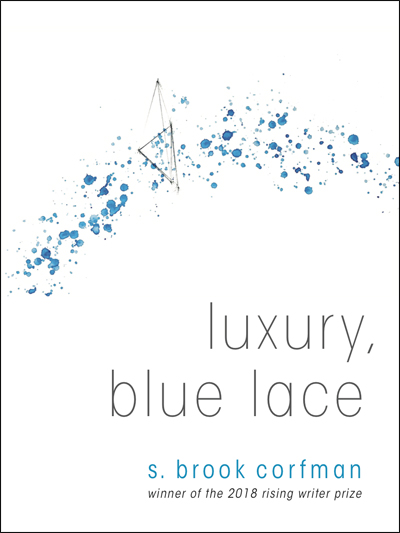
Luxury, Blue Lace (Autumn House Press, 2019) by S. Brook Corfman is not only a collection about queerness, but also is queer. What I mean is that queerness becomes a prosodic form—a pattern of shapeshifting formal choices and a number of poetic sequences that both uphold and bend the implications of linearity. While Corfman and I were talking, we meandered onto the topic of Agnes Martin. Corfman said, “For the most part, all of her lines are hand drawn—so if you’re able to zoom in on those lines there are actually a ton of variations, yet from afar it looks like a perfect grid. I was fascinated by this idea that the human line is variable even when it looks straight.” Now when I go back to Luxury, Blue Lace I think of the collection as an Agnes Martin painting: beautiful in how it distorts our notions of simplicity. William Blake’s work in all mediums does exactly that—his work often takes on what we too quickly brush off as simple, whether that is children or the binary of heaven and hell. His work asks us to question our judgements, to take a closer look.
S.Yarberry: How did William Blake’s printing process, as outlined in the Joseph Viscomi article “Blake’s Invention of Illuminated Printing, 1788,” [Ed.: An updated essay on illuminated printing by Viscomi is at the Blake Archive] affect your understanding of Blake’s work? Why was that important to you? How did this printing process affect your own writing?
S. Brook Corfman: What I like about that article is that it undoes an assumption that I had—that Blake was a poet first and that he illustrated his poems second. I think that is a pretty common assumption, at least in the poetry community. This article does a good job explaining that he was actually trying to print other things, then realized he could also print words on the visual plates. This means his art and writing are entangled in a much more complex way than I had previously thought—knowing this changed how I read his illuminated poems.
Learning about Blake’s process made me try and read the poems from the plates themselves, which I had never really done before—I had initially spent more time with just the words, typed out separately, and glanced at the images on the plates before or after. So I’d look and think, Okay, these words are in a weird mix of cursive and block print, and then I would turn the page and read the poem. Or I’d be like, Hm, okay, there is a person sleeping at the bottom of this, and move on. But the script of the plates is strange—it’s very visual, it’s not overly invested in the clarity of each letter or word. And I think that’s important to the prints—if there’s something slightly illegible or extraneous in terms of meaning in a particular mode of display, that adds a visual quality to the writing, a visual texture. You’re looking at the words partially in the same way you’re looking at the images, rather than reading only for meaning. I think about that in my own work too—about when a poem makes itself in service only to lettered or semiotic meaning, versus other kinds of meaning. I sometimes think of reading as a very dematerializing process—you’re not really thinking about the page or the shape of the letters—you’re always trying to get to the meaning of a word that exists separately from the letters. Blake’s work seemed to say that’s not really true: reading can be a more tactile experience.
Citizen by Claudia Rankine came out around the time I first started learning about Blake. One thing people talked a lot about, in regard to Citizen, was the pages—which are this heavier, more expensive type of paper than is usually used for an average poetry book. But I didn’t hear a lot of discussion over what that meant for the reading experience of the book, how the ability of this paper to hold images or texts was deployed. Because it could offer us a weird other kind of image-text formation, but it doesn’t: it largely separates the text, separates the images. There is the Glenn Ligon spread in the center that emphasizes to the reader that these pages can be doing anything, but mostly in the book these pages still aren’t. Instead of thinking negatively, This book doesn’t go far enough, I think that Citizen and Blake draw attention to what we (the reader) want out of poems, out of reading—or at least a kind of normative expectation. Additionally, this decision emphasizes the tension that comes from holding a variety of aesthetic experiences at the same time. Which led me to think that you can enrich your sense of a poem if you consider what else the page could potentially hold, and what are the constraints that do, or do not, let it hold that.
SY: Often in thinking about Blake we have, myself included, been divorcing art and writing as two separate aspects of Blake’s oeuvre, when really they are functioning as one. We should, instead, be thinking about the text and image as simultaneous ideas that may, or may not, be directly correlating; perhaps, the images and texts are almost associative leaping through mediums—avoiding an obvious connection. This actually segues nicely into this question of the ekphrastic. Do you consider Blake’s work ekphrastic? He is not someone who usually comes up in conversations of ekphrastic writing, although it’s intriguing to think of him in that context. And how does the ekphrastic play into Luxury, Blue Lace?
SC: I do not think that Blake is an ekphrastic poet; I would not use that label. Now, what is useful to me as someone who hasn’t (yet) merged the two forms of visual art and poetry, like Blake has, is that the ekphrastic mode of writing is porous to concepts or ways of writing—it’s a way of thinking of visual art and poetry as networks without going as far as combining them. In regard to Blake’s poems and prints, they are so intertwined that they essentially are each other. Before I was writing the poems in Luxury, Blue Lace I was writing a lot of ekphrastic work because I was learning to write about a feeling without literally reproducing the scenario. For example, I was in Italy and was going to all these art museums and literally everything was covered in gold. Gold everywhere—to the point that it was disgusting, it felt like it was attacking me! So I was working on this poem that never went anywhere, but I was trying to write about this feeling of the visuality, materiality, of the gold—its literal shine. This poem was trying to reconcile this visuality with the disgust that I had—which isn’t usually the feeling I associate with gold—without reproducing for the reader, I am in a museum; I am looking at all the gold. Writing in this mode was like training for Luxury, Blue Lace, which talks about gender by using a visual form (the poem). I ended up thinking, How do you collect the impressions and the words that give rise to a feeling without having to do the narrative groundwork? If we don’t provide that narrative, can we access the feeling in a different way, or through other means? How does that help us come to a different understanding?
SY: One similarity between Songs of Innocence and of Experience and Luxury, Blue Lace is the writing of childhood and childhood experiences. Can you talk about the challenges of writing about childhood? I think you do so in a way that captures those experiences without sounding nostalgic or didactic, yet you still very much engage with things like a playground, toys, and kindergarten marriage vows. Whereas Blake constructs these strange archetypal childhoods that seem at times to dodge, at other times to distort, reality—you, or your poems, seem very much endowed with the reality and materiality of youth.
SC: I think something that both Blake and I share is that we think childhood is very mysterious. The distinction you point out about how we go about engaging with that mysteriousness is apt, yet I think that it stems from the same place. We, Blake and I, have had this strange experience of childhood that we no longer have access to. Blake’s way of going about it is, as you said, archetypal, and mobilizing the symbolism culturally imbued into the figure of the child. My way was to do, somewhat, the opposite and think about the objects and situations that I remembered even if I didn’t remember all of the feelings I had associated with them. In that poem you mention with the marriage vows—I did get “married” in kindergarten on the playground with one of these ring pops, which is kind of surprising to me now—we really knew exactly what marriage was. It wasn’t a joke an adult made about our friendship or something, it wasn’t a joke at all—we liked each other so much, so we thought we should get married! That felt very clear to us. This was at a time in my childhood where my gender presentation was pretty ambiguous, so it wasn’t as simple as I am the groom, you are the bride. But I don’t remember what specifically prompted it, only that as five-year-olds we understood that important relationships were expressed through marriage—and, also, that it was more or less allowed. No one was worried about our relationship, even though there was a lot of kissing on the cheek. So thinking about childhood for me was thinking that there are many things I do remember, there are many things I don’t, and there are many things that I remember doing but don’t actually remember what it felt like to do them or why I did them. This led to the material things becoming very important in tracking memory and telling this story.
SY: In your poem “The Crisis II” you write, “Or it is true that eroticism can be other than sexual. I wanted to stay small and held” (22). I found that a deeply interesting moment and one that seems an apt engagement with some of the themes Blake is interested in—this familial intimacy that gets broken in some way or another. I am working with the poems “The Little Boy Lost” and “The Little Boy Found” right now—where the father abandons the boy, who is found by the heavenly father and returned to his mother. There is a joyful ending, but the father is still absent. This plays out literally in the poems, but, of course, is ripe with more metaphorical readings. I am curious if you could talk about the way parenthood becomes a thematic resonance in your poems—either literally or figuratively.
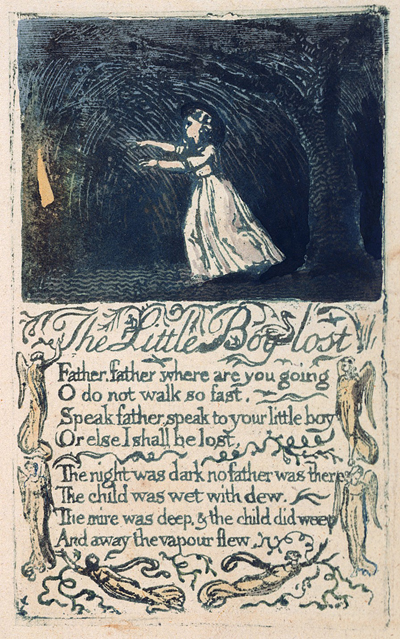
SC: I am lucky to still have a very positive relationship with my parents. When I was writing this book I showed my parents drafts and we talked about it. I tried not to do too much research, since I was interested in my own version of what I remembered. It became very clear to me that during my childhood my parents were trying to help me express myself and my gender in as full and as safe a way as possible. And safety is a tricky word—now, we don’t agree always on what was safe and what wasn’t, but one way to think about the pivot in “The Little Boy Lost” and “The Little Boy Found” is that these poems reveal, and critique, the ambivalence of parenthood—who is responsible and how do we share that responsibility? How much are we realistically responsible for regarding the protection of our children? How do our children exceed what we can imagine?
SY: I think that all throughout Songs of Innocence and of Experience, whether the figure of the parent is present or not, there is still going to be danger, there are still going to be these violences that happen regardless. Another poem from Songs of Innocence and of Experience you have previously mentioned that you were interested in is “The Sick Rose.” What interests you about that poem? You used the phrase “circuitous morality”—could you talk about what you mean by that?
SC: One thing I love in general in poems, especially in Blake’s poems, is when the pattern skips, or glitches. In Blake’s work there are not necessarily morals, but there does seem to be this idea that there is a good outcome and a bad outcome. Then there are some poems where that binary feels more fraught, like “The Sick Rose.” In the last two lines, “And his dark secret love / Does thy life destroy,” I think there are two ways of reading these lines. Does that mean that the worm’s dark secret love destroys the rose’s life? Or does the rose’s life destroy the worm’s dark secret love? Since the syntax is contorted it seems like it could technically go either way. But the uncertainty here is fatalistic—in both readings the rose is sick.
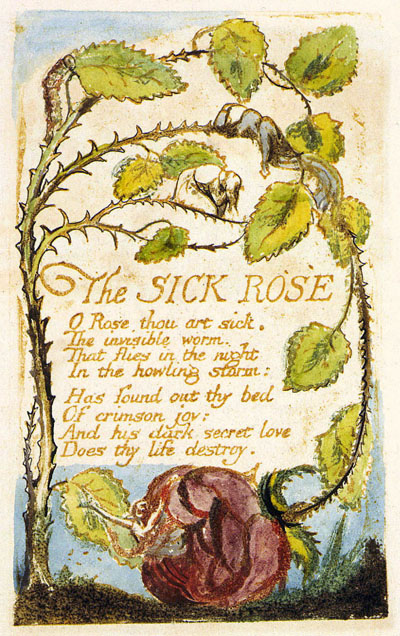
SY: This poem does read very symbolically to me—that the rose is a symbol of X and the worm is a symbol for Y, but there’s almost not enough provided to be able to say easily what X and Y signify. Which goes back to what you mentioned about Blake usually having these clear-cut versions of what is good and bad (at least to him). The question that sticks out to me here is, What is being critiqued? Since there does seem to be a critique being made about sex and sexuality—the rose generally being associated with womanhood and the worm being very phallic, especially the “his” that comes in at the very end. The rose does seem feminine; however, it is also growing thorns, which has a phallic resonance too.
SC: I love this first line, “O Rose thou art sick.” Period. It’s so different from most odes because it has a diagnosis, yet that diagnosis provides no information. It doesn’t help us understand the relationship or the problem, other than that the rose is sick, and/or there’s some version of toxic love that is making it that way.
SY: It is hard to parse here whether the sickness is a metaphorical sickness or a literal sickness. In a poem about roses I think we want to read it as metaphorical, but there does seem to be a more literal critique. This, of course, being a time where people were dying of STDs. It seems, and this is very much conjecture, one read of the poem is the harsh reality of illness literally infecting the icon of love and romance.
SC: While you were talking it reminded me that what I know and think about Blake is mostly formal, whereas you have more knowledge of his body of work, a more historicized understanding of his poems and the exegesis of his metaphors, and whatnot. So much of what I turn to Blake for is this formal progenitor of the visual poetic hybrid. We make a good duo.
SY: We do make a good duo! Thinking about form, though—to quote from an email you sent me—“Reading Blake (and the medieval alliterative poets) was the moment in which I really began to understand that rhyme had culturally specific (and temporally specific) meanings, that rhyme wasn’t always ‘juvenile.’” First off, can you expand a little bit on that idea of rhyme? And/or did rhyme inform any of the ideas or choices you made prosodically in the poems of Luxury, Blue Lace?
SC: Even with my revelation—I still struggle with rhyme. It is so culturally built into me to associate rhyme with a more elementary style of writing that I have really to be conscious when I interact with those types of poems. But it’s also so interesting to me, now, because it wasn’t that long ago—poets were writing rhymed poetry pretty consistently until late in the twentieth century—it remained one of the formal marks of poetry until pretty recently. So it’s interesting to me that I’m so averse to it, that the artifice of it captures me. In regard to Blake, it is easier for me to slip out of this natural resistance to rhyming in a lot of ways because his poems are strange, and in some ways they evoke my misconceptions about rhyme in order to complicate them. I don’t write in a lot of traditional stanzaic forms, although I have a strong internal/gut sense of rhythm and read the book aloud over and over when I was writing and editing. So the language has to hold that rhythm in a different way, if there are fewer stanzas or line breaks—the syntax has to hold it, perhaps. One question I have been thinking about in my own work, which I cannot answer for you now, is, What am I resistant to in prosody and form? In the prose poem, which I love, there is still that rhythm to the language, but you really have to work for it, since you don’t get those same markers as you do with rhyme and stanzas, but that doesn’t mean they aren’t there. I think Blake and I have that in common—we both ask a lot of our readers. Rhyme is a good way to think about a big difference in our styles: Blake gives you a lot of sensory information—the visuals, the words, rhyme, stanzas, symbols. When reading Blake one must think about how to hold these components together—since each alone is so bright. My writing is more reticent—it asks you to come forward, to let the components come together. Pointillism, maybe, like one poem notes.
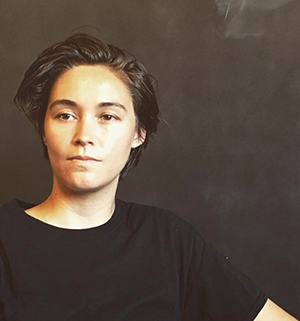
S. Yarberry is a trans poet and writer. Their poetry has appeared in, or is forthcoming in, Tin House, Indiana Review, the Offing, Berkeley Poetry Review, jubilat, the Washington Post’s Lily magazine, Notre Dame Review, and miscellaneous zines. Their other writings can be found in Bomb magazine. S. holds the junior teaching fellowship in poetry at Washington University in St. Louis and serves as the poetry editor of the Spectacle.
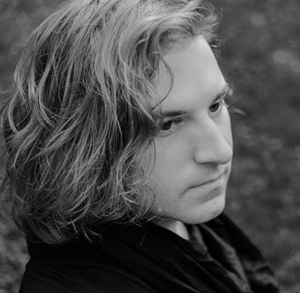
S. Brook Corfman is the author of Luxury, Blue Lace (chosen by Richard Siken for the Autumn House Rising Writer Prize) and two chapbooks: the letterpress Meteorites from DoubleCross Press and the digital collection of performance pieces The Anima (GaussPDF). @sbrookcorfman
